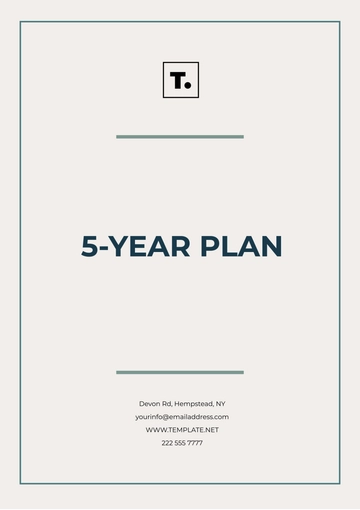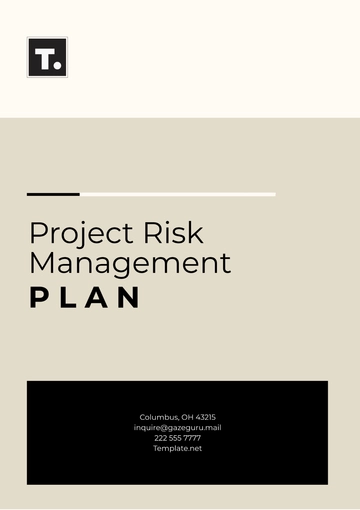Free CEO Plan

I. Executive Summary
The CEO strategic plan for [Your Company Name] outlines a comprehensive approach for achieving long-term success, focusing on growth, sustainability, and technological innovation. This plan provides a clear framework to guide the company through the next decades, ensuring that it remains competitive in an increasingly dynamic market. By embracing emerging technologies, diversifying product offerings, and expanding into new geographic markets, [Your Company Name] aims to achieve a [30%] annual revenue growth, increase market share, and reduce environmental impact by [40%] by 2055. The plan also emphasizes the importance of stakeholder engagement, customer retention, and organizational excellence to secure the company's long-term sustainability and industry leadership.
The strategy is designed with flexibility in mind, allowing [Your Company Name] to navigate any challenges that may arise in the evolving business landscape. It leverages both current trends and anticipates future disruptions, positioning the company to not only adapt but to lead and innovate in the industry.
II. Vision and Mission
A. Vision
By 2055, [Your Company Name] will be the undisputed leader in [specific industry/sector], known for its commitment to innovation, customer-centric solutions, and sustainability. Our vision is to shape the future of the industry by pioneering cutting-edge technologies, providing unparalleled customer experiences, and fostering a culture of inclusivity and corporate responsibility.
B. Mission
The mission of [Your Company Name] is to deliver transformative, high-quality products and services that empower businesses and communities worldwide. We will achieve this by continuously evolving through innovation, adopting a customer-first approach, and adhering to the highest standards of ethical conduct. Our dedication to excellence and sustainability will ensure we remain a trusted partner for our clients and a leader in the global marketplace.
III. Core Objectives
A. Strategic Growth
Revenue Growth
Our goal is to achieve an average annual revenue growth of [30%]. This will be accomplished by expanding into high-growth international markets, strengthening our presence in existing regions, and diversifying our product portfolio. We expect the growth rate to remain consistent through 2055, with our revenue reaching [$21.97 billion] by that year.Customer Retention
A key focus for [Your Company Name] is enhancing customer satisfaction and loyalty. Through the introduction of personalized services, better customer engagement, and more efficient support systems, we aim to increase customer retention by [20%] by 2055.
B. Innovation Leadership
Research & Development Investment
To maintain our competitive edge, we will allocate [$500 million] annually to research and development. This funding will support innovation in areas such as AI, IoT, automation, and renewable energy technologies. By 2053, we aim to launch at least [10] new products or services annually, solidifying our reputation as a technology leader.Diversified Product Portfolio
[Your Company Name] will diversify its offerings by introducing at least [5] new product lines each year. This will include a strong focus on AI-powered, sustainable, and data-driven solutions, ensuring that we meet the evolving demands of our customers.
C. Sustainability
Carbon Emissions Reduction
As part of our environmental strategy, we will reduce carbon emissions across all operations by [40%] by 2055. This goal will be achieved through process optimization, increased energy efficiency, and the adoption of renewable energy sources.Circular Economy Adoption
By 2055, [Your Company Name] will ensure that [90%] of our products are recyclable or reusable. We will prioritize sustainable sourcing and develop products that contribute to a circular economy, minimizing waste and promoting resource efficiency.
IV. Market Analysis
A. Global Market Trends
Technological Advancements
The next few decades will see significant growth in the adoption of AI, machine learning, and automation across all industries. It is estimated that AI will contribute [$15 trillion] to the global economy by 2050. As such, [Your Company Name] is committed to integrating these technologies into our operations and product offerings to stay ahead of the curve.Sustainability Demand
Consumers and businesses alike are becoming increasingly aware of environmental issues. The global market for sustainable products is expected to grow by [50%] by 2053, creating new opportunities for companies like [Your Company Name] that are committed to green practices.
B. Competitive Landscape
[Your Company Name] faces competition from leading companies in the tech industry, including [Top Competitor A], [Top Competitor B], and [Top Competitor C]. While these companies hold significant market shares, [Your Company Name]'s commitment to sustainability, innovation, and customer engagement provides a strong competitive advantage.
Competitor | Market Share (%) | Key Strengths |
|---|---|---|
Top Competitor A | 25 | Strong global presence, diverse offerings |
Top Competitor B | 20 | Advanced AI capabilities, industry leader in automation |
Top Competitor C | 15 | Strong sustainability programs, eco-friendly products |
V. Strategic Initiatives
A. Business Expansion
Geographic Growth
Expanding into new markets is a critical part of [Your Company Name]'s strategy to increase its revenue and market share. As the global economy continues to evolve, there are significant opportunities in emerging markets, particularly in Asia and Africa. By 2052, we aim to establish a presence in [5] new countries, targeting regions with high-growth potential such as India, Southeast Asia, Sub-Saharan Africa, and the Middle East. These markets are projected to experience GDP growth rates exceeding [6%] annually over the next several decades. In these regions, there is a rising demand for technological solutions, innovative products, and sustainable business practices—all areas where [Your Company Name] excels.To successfully enter these markets, we will establish local partnerships, adapt our product offerings to regional needs, and invest in community outreach programs to build trust and brand recognition. We will also focus on strengthening our logistics and supply chain operations in these regions to ensure a smooth expansion process. The goal is to capture at least [10%] market share in each new country within [5 years] of entry.
Product Diversification
[Your Company Name] recognizes the importance of a diversified product portfolio to meet the evolving demands of global customers. To that end, we will launch at least [5] new product lines every year, ensuring that our offerings remain relevant and competitive. These new products will focus on high-growth sectors, including Artificial Intelligence (AI), Internet of Things (IoT), renewable energy, and advanced data analytics solutions.By 2055, we aim for our diversified product portfolio to account for [40%] of total revenue. This shift will reduce dependency on existing product lines and provide us with an opportunity to tap into new revenue streams. In addition, each new product line will undergo a sustainability assessment to ensure it aligns with our long-term environmental goals. We will also prioritize the development of digital-first products and services, responding to the growing demand for technology-driven solutions in various industries.
B. Operational Excellence
Digital Transformation
To remain competitive and agile, [Your Company Name] will undergo a complete digital transformation, integrating advanced technologies into all aspects of our operations. Over the next decade, we will invest [$200 million] annually in upgrading our digital infrastructure, enhancing our capabilities in AI, machine learning, blockchain, and automation.The goal is to streamline operations, improve efficiency, and reduce costs through the use of intelligent systems. By automating repetitive tasks and optimizing supply chain management, we expect to reduce operational costs by [15%] by 2055. Furthermore, we will implement a cloud-based enterprise resource planning (ERP) system to improve real-time decision-making and enable seamless collaboration across regions.
In addition, we will develop an integrated data analytics platform to collect and analyze customer data, providing insights that will help tailor marketing campaigns, product offerings, and customer service solutions. This platform will also enhance our ability to predict market trends and identify new business opportunities, giving us a competitive edge in the industry.
Talent Development
At [Your Company Name], our employees are our greatest asset. As we expand globally and pursue new strategic initiatives, it is essential to invest in the development of our workforce. We will allocate [$50 million] annually to employee training programs, which will focus on leadership development, technical skills, and fostering a culture of innovation.By 2055, we aim to create a leadership pipeline that ensures succession planning at every level of the organization. We will offer comprehensive training and mentorship programs to help employees advance their careers within the company. In addition, we will prioritize diversity and inclusion initiatives, ensuring that our workforce reflects the global communities we serve. Employee engagement will be monitored through regular surveys, and we will set a target retention rate of [85%], with a focus on reducing turnover and enhancing job satisfaction.
VI. Financial Projections
A. Revenue Forecast
The revenue forecast for the next several years is based on our aggressive growth targets and strategic initiatives. We have set a goal to achieve [30%] annual revenue growth through global expansion, product diversification, and operational optimization.
Year | Revenue ($ billion) | Growth Rate (%) |
|---|---|---|
2050 | 10.0 | 30 |
2051 | 13.0 | 30 |
2052 | 16.9 | 30 |
2053 | 21.97 | 30 |
2055 | 40.0 | 30 |
This revenue growth will be driven by the successful implementation of our geographic expansion strategy, diversification of our product offerings, and continued focus on innovation in technology and sustainability. We anticipate that our new product lines will account for a significant portion of this revenue, providing new sources of income and ensuring long-term profitability.
B. Investment Allocation
To support our strategic initiatives, we have outlined a robust investment allocation plan. This plan will focus on driving innovation, expanding our global footprint, and improving operational efficiency.
Area of Investment | Annual Investment ($ million) |
|---|---|
Research & Development (R&D) | 500 |
Sustainability Initiatives | 300 |
Marketing & Customer Engagement | 250 |
Digital Transformation | 200 |
Employee Training & Development | 50 |
The largest portion of our investment will go towards research and development (R&D), ensuring that we stay ahead of market trends and continue to offer cutting-edge solutions to our customers. Sustainability initiatives will also receive a significant portion of the budget, reflecting our commitment to environmental responsibility and long-term corporate sustainability.
VII. Key Performance Indicators (KPIs)
A. Financial Metrics
Revenue Growth
The primary financial metric will be achieving [30%] annual revenue growth, which will ensure that we meet our long-term financial targets. By 2055, we aim to reach [$40 billion] in revenue, driven by successful market expansion and product diversification.Net Profit Margin
We will also target a net profit margin of [20%] by 2055. This will be achieved through a combination of cost reductions, efficiency improvements, and higher-margin product lines. We expect the digital transformation and automation efforts to play a key role in improving profitability.
B. Customer Metrics
Customer Satisfaction
Maintaining high customer satisfaction is critical to our business success. We aim to achieve a customer satisfaction score (CSAT) of [95%] by 2055, ensuring that our clients are not only satisfied with our products but also remain loyal advocates for our brand.Net Promoter Score (NPS)
Our goal is to achieve an NPS of [80] by 2055, reflecting the strength of our customer relationships. A high NPS will indicate that our customers are not only satisfied but are also highly likely to recommend our products and services to others.
C. Operational Metrics
Cost Reduction
Through digital transformation, process optimization, and the implementation of AI technologies, we aim to reduce operational costs by [15%] by 2055. This will contribute to improved profitability and allow for more reinvestment in innovation and growth initiatives.Employee Retention
Our target employee retention rate is [85%], reflecting our commitment to creating a positive work environment and offering career development opportunities. A high retention rate will help ensure continuity and organizational knowledge, which are essential as we continue to expand globally.
VIII. Risk Management Plan
A. Identified Risks
Market Volatility
Global economic fluctuations, such as recessions or unexpected shifts in market demand, pose a risk to revenue growth. To mitigate this, [Your Company Name] will diversify its market presence, focusing on both developed and emerging markets. We will also maintain a flexible product portfolio to adapt to changing market conditions.Technological Disruption
The fast-paced nature of technological innovation means that our products and services may become obsolete if we do not keep up with industry advancements. To address this risk, we will continuously invest in R&D and remain flexible in our business model, incorporating emerging technologies such as AI, blockchain, and renewable energy solutions.
B. Contingency Strategies
Reserve Fund
To safeguard against unforeseen market disruptions, we will establish a reserve fund of [$1 billion]. This fund will be used to support operations in case of economic downturns or unexpected challenges, ensuring business continuity even in uncertain times.Crisis Management Teams
We will set up crisis management teams that can respond swiftly to potential risks. These teams will be equipped to handle situations such as market crashes, natural disasters, or sudden supply chain disruptions. The teams will be trained to execute pre-established contingency plans, ensuring a rapid and effective response to minimize impact.
IX. Implementation Timeline
The implementation timeline provides a clear roadmap for the execution of the strategic plan, broken down into phases:
Phase | Timeline | Key Deliverables |
|---|---|---|
Phase 1: Planning | Q1 2050 – Q4 2050 | Strategy development, approval of budgets, market analysis |
Phase 2: Execution | Q1 2051 – Q4 2053 | Geographic expansion, product launches, digital infrastructure upgrades |
Phase 3: Optimization | Q1 2054 – Q4 2055 | Evaluation of outcomes, fine-tuning strategies, strengthening customer engagement |
X. Conclusion
The CEO strategic plan for [Your Company Name] is an ambitious, forward-thinking roadmap for success. Through strategic geographic expansion, product diversification, and operational excellence, we will ensure that [Your Company Name] continues to grow and lead in the tech industry. The plan’s emphasis on innovation, sustainability, and customer satisfaction will allow us to stay competitive in a rapidly changing global marketplace, achieving a dominant position by 2055. By executing this plan, we will not only meet our growth targets but also set new standards of excellence in every aspect of our operations.
- 100% Customizable, free editor
- Access 1 Million+ Templates, photo’s & graphics
- Download or share as a template
- Click and replace photos, graphics, text, backgrounds
- Resize, crop, AI write & more
- Access advanced editor
Achieve strategic success with the CEO Plan Template from Template.net. This editable and customizable tool is designed to outline executive objectives, initiatives, and responsibilities. Easily tailor it to fit your leadership goals using the AI Editor Tool. Download now to create a comprehensive roadmap for impactful decision-making.
You may also like
- Finance Plan
- Construction Plan
- Sales Plan
- Development Plan
- Career Plan
- Budget Plan
- HR Plan
- Education Plan
- Transition Plan
- Work Plan
- Training Plan
- Communication Plan
- Operation Plan
- Health And Safety Plan
- Strategy Plan
- Professional Development Plan
- Advertising Plan
- Risk Management Plan
- Restaurant Plan
- School Plan
- Nursing Home Patient Care Plan
- Nursing Care Plan
- Plan Event
- Startup Plan
- Social Media Plan
- Staffing Plan
- Annual Plan
- Content Plan
- Payment Plan
- Implementation Plan
- Hotel Plan
- Workout Plan
- Accounting Plan
- Campaign Plan
- Essay Plan
- 30 60 90 Day Plan
- Research Plan
- Recruitment Plan
- 90 Day Plan
- Quarterly Plan
- Emergency Plan
- 5 Year Plan
- Gym Plan
- Personal Plan
- IT and Software Plan
- Treatment Plan
- Real Estate Plan
- Law Firm Plan
- Healthcare Plan
- Improvement Plan
- Media Plan
- 5 Year Business Plan
- Learning Plan
- Marketing Campaign Plan
- Travel Agency Plan
- Cleaning Services Plan
- Interior Design Plan
- Performance Plan
- PR Plan
- Birth Plan
- Life Plan
- SEO Plan
- Disaster Recovery Plan
- Continuity Plan
- Launch Plan
- Legal Plan
- Behavior Plan
- Performance Improvement Plan
- Salon Plan
- Security Plan
- Security Management Plan
- Employee Development Plan
- Quality Plan
- Service Improvement Plan
- Growth Plan
- Incident Response Plan
- Basketball Plan
- Emergency Action Plan
- Product Launch Plan
- Spa Plan
- Employee Training Plan
- Data Analysis Plan
- Employee Action Plan
- Territory Plan
- Audit Plan
- Classroom Plan
- Activity Plan
- Parenting Plan
- Care Plan
- Project Execution Plan
- Exercise Plan
- Internship Plan
- Software Development Plan
- Continuous Improvement Plan
- Leave Plan
- 90 Day Sales Plan
- Advertising Agency Plan
- Employee Transition Plan
- Smart Action Plan
- Workplace Safety Plan
- Behavior Change Plan
- Contingency Plan
- Continuity of Operations Plan
- Health Plan
- Quality Control Plan
- Self Plan
- Sports Development Plan
- Change Management Plan
- Ecommerce Plan
- Personal Financial Plan
- Process Improvement Plan
- 30-60-90 Day Sales Plan
- Crisis Management Plan
- Engagement Plan
- Execution Plan
- Pandemic Plan
- Quality Assurance Plan
- Service Continuity Plan
- Agile Project Plan
- Fundraising Plan
- Job Transition Plan
- Asset Maintenance Plan
- Maintenance Plan
- Software Test Plan
- Staff Training and Development Plan
- 3 Year Plan
- Brand Activation Plan
- Release Plan
- Resource Plan
- Risk Mitigation Plan
- Teacher Plan
- 30 60 90 Day Plan for New Manager
- Food Safety Plan
- Food Truck Plan
- Hiring Plan
- Quality Management Plan
- Wellness Plan
- Behavior Intervention Plan
- Bonus Plan
- Investment Plan
- Maternity Leave Plan
- Pandemic Response Plan
- Succession Planning
- Coaching Plan
- Configuration Management Plan
- Remote Work Plan
- Self Care Plan
- Teaching Plan
- 100-Day Plan
- HACCP Plan
- Student Plan
- Sustainability Plan
- 30 60 90 Day Plan for Interview
- Access Plan
- Site Specific Safety Plan





























